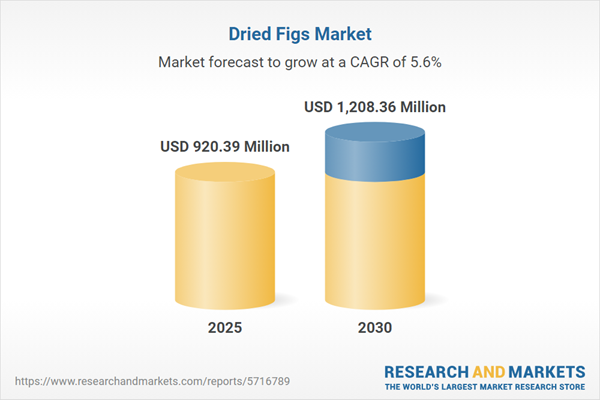The global dried figs market is poised for significant growth in the coming years, driven by increasing consumer demand for healthy, nutrient-rich foods and the expanding applications of dried figs in various food sectors. Ficus carica, commonly known as the fig, is valued for its sweet flavor, chewy texture, and rich nutritional profile, including antioxidants, phytochemicals, enzymes, and vitamins. With no fat content, dried figs are recognized for their potential to reduce the risk of heart disease, certain cancers, and stroke. The market is expected to benefit from rising disposable incomes, population growth, and growing urbanization, which are enhancing consumer health consciousness and increasing the availability of dried figs through groceries, superstores, and retail outlets.
Technological advancements in the production of high-quality dried fig products are projected to further propel market expansion. The versatility of dried figs in the food industry, including their use in desserts, snacks, bars, bakery goods, confectioneries, cereals, and dairy products, is a significant growth driver. The increasing preference for healthy food options is likely to sustain demand, as consumers prioritize products with health benefits.
Growth Drivers
The medicinal properties of dried figs are a key factor driving market growth. Figs are utilized in various traditional medicine systems, including the Unani system, European herbal medicine, and Iranian traditional medicine. They are noted in historical texts like the first edition of the Dispensatory of the United States of America for their therapeutic applications. Dried figs are particularly valued for their ability to increase blood hemoglobin levels by improving iron balance, aiding in the treatment of iron-deficient anemia. Their high antioxidant content helps neutralize free radicals, supporting overall health, while their dietary fiber promotes digestive health and aids in weight management. The American Diabetes Association recommends figs as a high-fiber option for diabetes management, and fig leaves are known to reduce insulin requirements for diabetic patients. The rising prevalence of health concerns such as anemia and diabetes is expected to further boost demand for dried figs.Geographical Outlook
The Middle East is anticipated to be a dominant region in the dried figs market. Turkey remains the world's leading producer and exporter of figs, accounting for approximately 60% of global dried fig exports, as stated by Mehmet Ali Işık, President of the Aegean Dried Fruits and Products Exporters' Association. Afghanistan also plays a notable role, with fig exports valued at $35 million USD in the previous year, primarily for medicinal use in traditional treatments. The region's strong production and export capabilities, combined with growing global demand, position it as a key player in the market.In summary, the dried figs market is set to expand due to increasing health awareness, versatile food applications, and robust production in regions like the Middle East. The nutritional and medicinal benefits of dried figs, coupled with advancements in production and distribution, will drive sustained growth in the coming years.
Key Benefits of this Report:
- Insightful Analysis: Gain detailed market insights covering major as well as emerging geographical regions, focusing on customer segments, government policies and socio-economic factors, consumer preferences, industry verticals, and other sub-segments.
- Competitive Landscape: Understand the strategic maneuvers employed by key players globally to understand possible market penetration with the correct strategy.
- Market Drivers & Future Trends: Explore the dynamic factors and pivotal market trends and how they will shape future market developments.
- Actionable Recommendations: Utilize the insights to exercise strategic decisions to uncover new business streams and revenues in a dynamic environment.
- Caters to a Wide Audience: Beneficial and cost-effective for startups, research institutions, consultants, SMEs, and large enterprises.
What do businesses use our reports for?
Industry and Market Insights, Opportunity Assessment, Product Demand Forecasting, Market Entry Strategy, Geographical Expansion, Capital Investment Decisions, Regulatory Framework & Implications, New Product Development, Competitive IntelligenceReport Coverage:
- Historical data from 2022 to 2024 & forecast data from 2025 to 2030
- Growth Opportunities, Challenges, Supply Chain Outlook, Regulatory Framework, and Trend Analysis
- Competitive Positioning, Strategies, and Market Share Analysis
- Revenue Growth and Forecast Assessment of segments and regions including countries
- Company Profiling (Strategies, Products, Financial Information, and Key Developments among others).
Cranes MarketSegmentation:
By Type
- Conventional
- Organic
By Application
- Bakery
- Snacks
- Dairy
- Others
By Distribution Channel
- Online
- Offline
- Supermarkets/Hypermarkets
- Specialty Stores
- Others
By Geography
- North America
- USA
- Canada
- Mexico
- South America
- Brazil
- Argentina
- Others
- Europe
- Germany
- France
- United Kingdom
- Others
- Middle East and Africa
- Saudi Arabia
- UAE
- Türkiye
- Others
- Asia Pacific
- China
- Japan
- South Korea
- India
- Others
Table of Contents
Companies Mentioned
- Valley Fig Growers
- Traina Foods
- Bella Viva Orchards
- Cardassilaris Family
- Aurora Natural
- Sunny Fruit (K.F.C. GIDA A.Ş.)
- St. Dalfour
- Nutra Fig
Table Information
| Report Attribute | Details |
|---|---|
| No. of Pages | 142 |
| Published | June 2025 |
| Forecast Period | 2025 - 2030 |
| Estimated Market Value ( USD | $ 920.39 Million |
| Forecasted Market Value ( USD | $ 1208.36 Million |
| Compound Annual Growth Rate | 5.6% |
| Regions Covered | Global |
| No. of Companies Mentioned | 8 |









